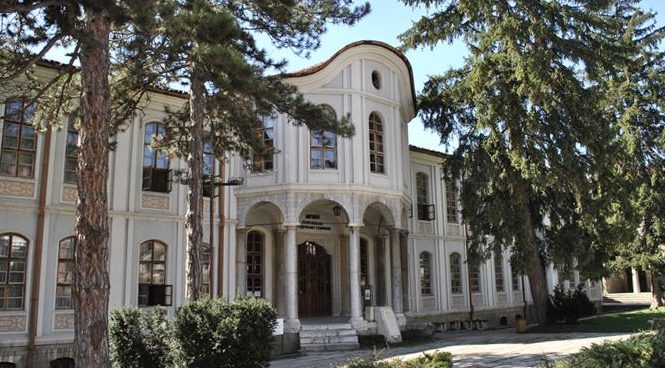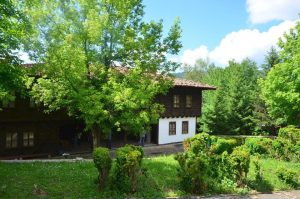

Regional Museum of History – Veliko Tirnovo is one of the largest museums in Bulgaria. Its subsidiaries are located in the city of Veliko Tirnovo in villages Arbanasi, Nikyup, Greek Quarter and near the town of Kilifarevo.
The museum contains the following objectives and exhibitions which introduces various historical eras- Roman and early Byzantine times, Medieval Bulgaria, Bulgarian national Revival, post-liberation history and the modernity, Architectural reservation “Tsarevets”, the “St. Peter and Paul” church ” Sf. Dimitar”, The church of “St. George” The church of “Birth” – Arbanasi, St. Archangels Michael and Gabriel” – Arbanasi, The Church of “Sf. Dimitar” – Arbanasi, The Church of “Sf. George” – Arbanasi, The Church of “Sf. Athanasius” – Arbanasi, The “House-Museum of Hadji Ilieva”, Archaeological Museum, Museum of “Revival and Constituent Assembly”, Museum of “Modern and Contemporary History”, Museum of “Prison”, Museum of “House Sarafkina”, The House Museum of “Petko R. Slaveykov”, Museum of Architectural Reservation “Arbanasi”, The “House Museum of Konstantsalieva”, The Museum of History – town of Kilifarevo, The House-Museum of “Filip Totyu”, The archeological Reservation “Nicopolis ad Istrum”, Ethnographic complex “River Osenarska” The House of “Leon Filipov”.
The Archaeological Museum is located to the west of “Union” Square in Veliko Tirnovo. It represents the millennial history and culture of the region by means of artifacts, exhibited in cronological order.
In the first room are the most oldest items ,dating back in Neolithic Age (years 5700-5000 in. Hr.) Are extremely valuable the ceramic exhibits showing at the bottom of the vessel a preceding writing system and the treasures of gold.
The second room of the exhibition shows the testimonies of the ancient period, pottery development in the region, sculpture and jewelry.
The third room is dedicated the period in which medieval Bulgarian capital was Tirnovo. The exhibits – royal seals, coins minted by the Bulgarian kings, etc. reflect the flourishing culture during the Second Bulgarian Kingdom (years 1185 – 1393).
Architectural reservation “Tsarevets”, located on the hill of the same name, this is one of the most important medieval monuments not only in Veliko Tirnovo, but also in Bulgaria. The hill was inhabited since the third millennium in. Hr. And the first fortress wall around it dates from the V – VIth centuries e.n. Metropolitan complex is located in the hills Tsarevets, Trapezitsa, Momina Fortress and Sveta Gora. Inaccessibility in a natural way will determine where the castle complex and patriarchal will be built. Today, the the patriarchal bell tower of the church is fully restored.
The Church “Sf. Dimitar” is located al the eastren foot of the hill Trapezitsa. Its history is linked with the announcement of Asan and Peter’s uprising (year 1185), leading to the restoration of the Bulgarian state. In this temple were crowned kings Peter (reigned in the years 1185 – 1197 în. Hr.), Asan (years 1186 – 1196) and Kaloyan (years 1197 – 1207).
The Church of “Sf. Petru and Pavel” is located at the foot of the northern slope of Tsarevets hill. It was built during the reign of Tsar Kaloyan (anii 1197 – 1207). After 1393, Together with the new monastic complex formed around the church serves as a patriarchal residence.
the late medieval church “St. George” in Veliko Tirnovo and “Birth”, “St. Archangels Michael and Gabriel”, “St. Dimitar”, “St. George” and “St. Athanasius” in Arbanasi show interest for visitors.
The Veliko Tirnovo guests can learn more by visiting the house museum “Filip Totyu” and ethnographic complex “Osenarska River” in Greek district, 40 km south of Veliko Tirnovo about life during Renaissance ( XVIII – XIX century). In the complex can be seen residential buildings, fullers and mills typical for this part of the Balkans.
Another possibility is alternatively visit the museums in Arbanasi “Kostantsalieva House” and “House Hadji Ilieva” 6 km from Veliko Tirnovo History and the Museum of History in Kilifarevo, 11 km south of Veliko Tirnovo. Arbanasi is a magnificent architectural reservation, where time seems to stopped. Here each hous has its story. There are, also, several churches and two monasteries.
Within the boundaries of Veliko Tirnovo of interesest is the House-Museum “Sarafkina”, which is the etnographic image of the region at the end of XIXth century and beginning of XXth century and the House-Museum “Petko Slaveykov” – the birthplace od the great Bulgarian poet and publisher.
History of Post-Liberation of Bulgaria (after 1878) is shown at the Museum “Revival and Constituent Assembly”. It is housed in the building where they held this memorial event for adoption the “Constitution of Tirnovo ” (year 1879), afer liberation od Bulgaria from ottoman domination. The building has been built by Kolio Ficeto (years 1800 – 1881) – Bulgarian Renaissance builder, and it is used as a mansion (headquarters of the authorities during the rule of the Ottoman Empire). Therefore, next to it is the only museum “Jail” where you can see recreations of the interiors of some of the cells and solitary, who served during the struggle for liberation.
Near the Museum “Modern and contemporary history,” were found more objects photographs and documentary materials about different historical events in the recent history of Bulgaria.
Archeological reservation “Nicopolis ad Istrum” is located 20 kilometers north of Veliko Tirnovo and covers the remains of the Roman city of the same name and the early Byzantine city built by the emperor Traian (years 98-117 before Chr.), In honor of the Roman victory over the Dacians at the beginning of the IInd century of the new era. The city had a strategic importance, as it was at the crossroads of two major thoroughfares – that from Odessos (Varna), through Serdika (Sofia), in the western provinces and that from Nove (Svishtov) to Byzantium (Istanbul) and and through the straits of provinces in Asia Minor. In the second half of the IInd century, the city was fortified with solid walls. Today, of interest are the ancient streets, the main street drains, the remains of a small theater and the town square, colonnaded street and public toilet with parts of the public bath.


